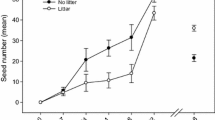Abstract
Transported distance and mortality of acorns scattered by rodents were investigated with magnets inserted into acorns (40 of Quercus serrata and 20 of Quercus acutissima) and a magnetic locator in a natural forest stand. All the treated acorns were transported, and 60% of them were discovered again with a magnetic locator from autumn to the next spring. Most transported acorns suffered predation within one month after the start of the experiment. Several acorns were rehoarded at least two or three times. Average transported distance of scattered acorns was 22.1±8.9 m (max=38.5 m) and the survival rate was 3.0%. The magnet method is one of the most effective methods for tracking acorns through the winter.
Similar content being viewed by others
References
Abbott H. G. & Quink T. F. 1970. Ecology of eastern white pine seed caches made by small forest mammals. Ecology 51: 271–278.
Darley-Hill S. & Johnson W. C. 1981. Acorn dispersal by the blue jay (Cyanocitta cristata). Oecologia 50: 231–232.
Hayashida M. 1988. The influence of social interactions on the pattern of scatterhoarding in red squirrels. Res. Bull. Exp. For. Hokkaido Univ. 45: 267–278 (In Japanese with English summary).
Howe F. H. & Smallwood J. 1982. Ecology of seed dispersal. Ann. Rev. Ecol. Syst. 13: 201–228.
Jensen T. S. 1982. Seed production and outbreaks of non-cycle rodent populations in deciduous forests. Oecologia 54: 184–192.
Jensen T. S. 1985. Seed-seed predator interactions of European beech, Fagus silvatica and forest rodents, Clethrionomys glareolus and Apodemus flavicollis. Oikos 44: 149–156.
Jensenk S. & Nielsen O. F. 1986. Rodents as seed dispersers in wood succession. Oecologia 70: 214–221.
Johnson W. C. & Adkisson C. S. 1985. Dispersal of beech nuts by blue jays in fragmented landscapes. Am. Midl. Nat. 113: 319–324.
Kanazawa Y. & Nishikata S. 1976. Disappearance of acorns from the floor in Quercus crispula forest. J. Jpn. For. Soc. 58: 52–56.
Kikuzawa K. 1988. Dispersal of Quercus mongolica acorns in a broadleaved deciduous forest, 1. Disappearance. For. Ecol. Manage. 25: 1–8.
Miguchi H. & Maruyama K. 1984. Ecological studies on natural beech forest (X X X VI), Development and dynamics of beech nuts in a mast year. Jpn. J. Ecol. 66: 320–327 (In Japanese with English summary).
Miyaki M. & Kikuzawa K. 1988. Dispersal of Quercus mongolica acorns in a broadleaved deciduous forest, 2. Scatterhoarding by mice. For. Ecol. Manage. 25: 9–16.
Oka T. 1992. Home range and mating system of two sympatric field mouse species, Apodemus speciosus and Apodemus argenteus. Ecol. Res. 7: 163–169.
Olmsted C. E. 1937. Vegetation of certain sand plains of Conneticut. Bot. Gaz. 99: 209–300.
Ooba S., Ishizuka M., Sugawara S. & Kanazawa Y. 1988. Several attempts to exterminate frugivorous insect larvae injuring Quercus mongolica var. grosseserrata acorns. Trans. Annu. Meet. Jpn. For. Soc. 99: 281–282 (In Japanese).
Price M. V. & Jenkins S. H. 1986. Rodents as Seed Consumers and Dispersers, pp 191–235. In: Murray D. R. (ed.) Seed Dispersal. Academic Press, Sydney, Australia.
Rood J. P. & Test F. H. 1968. Ecology of the spiny rat, Heteromys anomalus, at Rancho Grande, Venezuela. Am. Midl. Nat. 79: 89–102.
Saito S. 1981. Growth of seedlings of Japanese oak grown from acorns seeded at different depth. Trans. Annu. Meet. Hokkaido Branch Jpn. For. Soc. 30: 108–110 (In Japanese with English summary).
Shaw M. W. 1968. Factors affecting the natural regeneration of sessile oak (Quercus petraea) in north wales. J. Ecol. 56: 647–660.
Sork V. L. 1984. Examination of seed dispersal and survival in red oak Quercus rubra (Fagaceae), using metal-tagged acorns. Ecology 65: 1020–1022.
Vander Wall S. B. 1990. Food hoarding in animals. The University of Chicago Press, Chicago, USA.
Yasuda M., Nakagoshi N. & Takahashi F. 1991. Examination of spool-and-line method as quantitative technique to investigate seed dispersal by rodents. Jpn. J. Ecol. 41: 257–262 (In Japanese with English summary).
Author information
Authors and Affiliations
Rights and permissions
About this article
Cite this article
Iida, S. Quantitative analysis of acorn transportation by rodents using magnetic locator. Vegetatio 124, 39–43 (1996). https://doi.org/10.1007/BF00045142
Received:
Accepted:
Issue Date:
DOI: https://doi.org/10.1007/BF00045142




